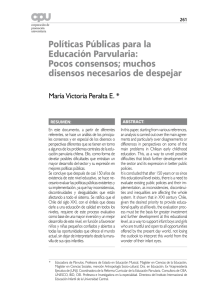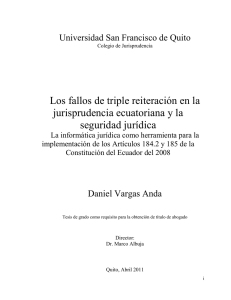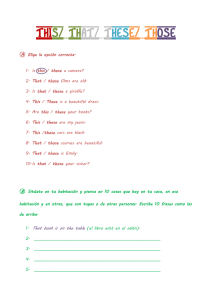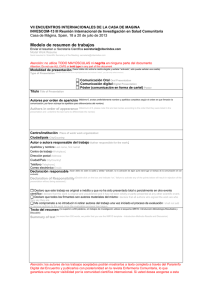Page 1 Emily Baierl Translated by a friend September 2013 There
Anuncio
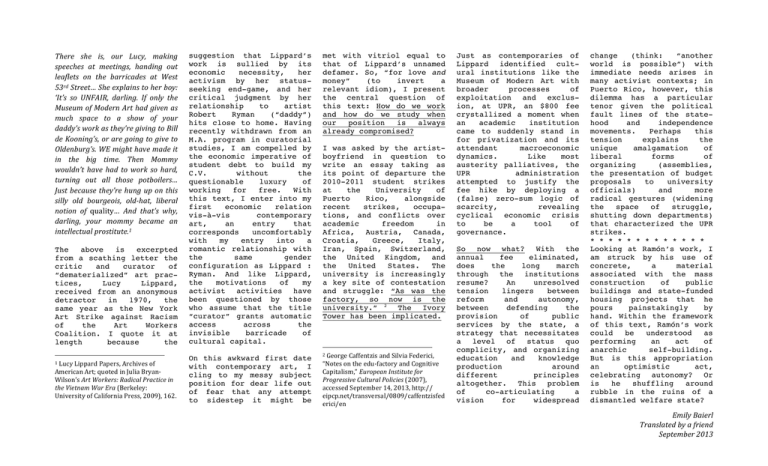
There she is, our Lucy, making speeches at meetings, handing out leaflets on the barricades at West 53rd Street… She explains to her boy: ‘It’s so UNFAIR, darling. If only the Museum of Modern Art had given as much space to a show of your daddy’s work as they’re giving to Bill de Kooning’s, or are going to give to Oldenburg’s. WE might have made it in the big time. Then Mommy wouldn’t have had to work so hard, turning out all those potboilers… Just because they’re hung up on this silly old bourgeois, old-­‐hat, liberal notion of quality… And that’s why, darling, your mommy became an intellectual prostitute.1 The above is excerpted from a scathing letter the critic and curator of “dematerialized” art practices, Lucy Lippard, received from an anonymous detractor in 1970, the same year as the New York Art Strike against Racism of the Art Workers Coalition. I quote it at length because the 1 Lucy Lippard Papers, Archives of American Art; quoted in Julia Bryan-­‐ Wilson’s Art Workers: Radical Practice in the Vietnam War Era (Berkeley: University of California Press, 2009), 162. suggestion that Lippard’s work is sullied by its economic necessity, her activism by her statusseeking end-game, and her critical judgment by her relationship to artist Robert Ryman (“daddy”) hits close to home. Having recently withdrawn from an M.A. program in curatorial studies, I am compelled by the economic imperative of student debt to build my C.V. without the questionable luxury of working for free. With this text, I enter into my first economic relation vis-à-vis contemporary art, an entry that corresponds uncomfortably with my entry into a romantic relationship with the same gender configuration as Lippard : Ryman. And like Lippard, the motivations of my activist activities have been questioned by those who assume that the title “curator” grants automatic access across the invisible barricade of cultural capital. On this awkward first date with contemporary art, I cling to my messy subject position for dear life out of fear that any attempt to sidestep it might be met with vitriol equal to that of Lippard’s unnamed defamer. So, “for love and money” (to invert a relevant idiom), I present the central question of this text: How do we work and how do we study when our position is always already compromised? I was asked by the artistboyfriend in question to write an essay taking as its point of departure the 2010-2011 student strikes at the University of Puerto Rico, alongside recent strikes, occupations, and conflicts over academic freedom in Africa, Austria, Canada, Croatia, Greece, Italy, Iran, Spain, Switzerland, the United Kingdom, and the United States. The university is increasingly a key site of contestation and struggle: “As was the factory, so now is the university.” 2 The Ivory Tower has been implicated. 2 George Caffentzis and Silvia Federici, “Notes on the edu-­‐factory and Cognitive Capitalism,” European Institute for Progressive Cultural Policies (2007), accessed September 14, 2013, http:// eipcp.net/transversal/0809/caffentzisfed erici/en Just as contemporaries of Lippard identified cultural institutions like the Museum of Modern Art with broader processes of exploitation and exclusion, at UPR, an $800 fee crystallized a moment when an academic institution came to suddenly stand in for privatization and its attendant macroeconomic dynamics. Like most austerity palliatives, the UPR administration attempted to justify the fee hike by deploying a (false) zero-sum logic of scarcity, revealing cyclical economic crisis to be a tool of governance. So now what? With the annual fee eliminated, does the long march through the institutions resume? An unresolved tension lingers between reform and autonomy, between defending the provision of public services by the state, a strategy that necessitates a level of status quo complicity, and organizing education and knowledge production around different principles altogether. This problem of co-articulating a vision for widespread change (think: “another world is possible”) with immediate needs arises in many activist contexts; in Puerto Rico, however, this dilemma has a particular tenor given the political fault lines of the statehood and independence movements. Perhaps this tension explains the unique amalgamation of liberal forms of organizing (assemblies, the presentation of budget proposals to university officials) and more radical gestures (widening the space of struggle, shutting down departments) that characterized the UPR strikes. * * * * * * * * * * * * * Looking at Ramón’s work, I am struck by his use of concrete, a material associated with the mass construction of public buildings and state-funded housing projects that he pours painstakingly by hand. Within the framework of this text, Ramón’s work could be understood as performing an act of anarchic self-building. But is this appropriation an optimistic act, celebrating autonomy? Or is he shuffling around rubble in the ruins of a dismantled welfare state? Emily Baierl Translated by a friend September 2013 Ahí está nuestra Lucy, dando discursos en reuniones, repartiendo panfletos en las barricadas de West 53rd Street… Ella le explica a su chico: “Es tan INJUSTO, cariño. Si al menos el Museo de Arte Moderno le hubiera dado tanto espacio a un show del trabajo de tu papi como le dan al de Bill de Kooning o el que le van a dar al de Oldenburg. Podríamos haber llegado a la cima. Así mamá no habría tenido que trabajar tanto, sacando todas esas chapuzas… Solo porque están atrapados en esta noción liberal de calidad tan estúpidamente burguesa y anticuada… Y es por eso, cariño, que tu madre se convirtió en una prostituta intelectual. 1 Este texto es un fragmento de una mordaz carta que la crítica y curadora de prácticas de arte “desmaterializado”, Lucy Lippard, recibió de un detractor anónimo en 1970, el año del Paro del Arte en New York contra el Racismo de la Coalición de Trabajadores del Arte. Hago esta extensa cita porque la sugerencia de que el trabajo de Lippard está mancillado por su necesidad económica, su activismo por su búsqueda de estatus y su juicio crítico por su relación con el artista Robert Ryman (papi) me toca de cerca. Tras haberme dado de baja de un programa de Maestría en Arte en estudios curatoriales, tengo la obligación, ante el imperativo económico de la deuda estudiantil, de construir mi C.V. sin poderme darme el lujo de trabajar gratis. Con este escrito, entro en mi primera relación vis-à-vis con el arte contemporáneo, una entrada que se corresponde incómodamente con mi entrada en una relación romántica con una configuración del mismo género que la de Lippard: Ryman. Y como Lippard, las motivaciones de mis actividades activistas se han cuestionado por aquellos que asumen que el título “curador” te concede acceso automático por la barrera invisible del capital cultural. En esta incómoda primera cita con el arte contemporáneo, me adhiero a mi problemática posición como si mi vida dependiese de ello por miedo a que cualquier intento de esquivarlo pudiera encontrarse con un veneno igual al del difamador anónimo de Lippard. Así, “por amor y dinero” (para invertir un modismo relevante), presento la pregunta central de este escrito: ¿Cómo trabajamos y cómo estudiamos cuando nuestra posición está siempre comprometida de antemano? Me invitó el artista-novio en cuestión a escribir un ensayo que tomara como punto de partida las huelgas estudiantiles del 2010-2011 en la Universidad de Puerto Rico, junto con huelgas recientes, ocupaciones y conflictos sobre la libertad académica en África, Austria, Canadá, Croacia, Grecia, Italia, Irán, España, Suiza, Reino Unido y los Estados Unidos. La universidad es, de modo creciente, un lugar clave de lucha y conflicto: “Como antes era la fábrica, así es ahora la Universidad.”2 La Torre de Marfil se ha implicado. Así como los contemporáneos de Lippard identificaron instituciones culturales como el Museo de Arte Moderno con procesos más amplios de explotación y exclusión, en la UPR, una cuota de $800 cristalizó un momento en el que la institución académica adoptó de repente una postura a favor de la privatización y su acólita dinámica macroeconómica. Como la mayoría de las medidas de austeridad, la administración de la UPR intentó justificar el alza de cuota presentando una (falsa) lógica de escasez tal cual un juego de suma cero, revelando cómo la crisis económica cíclica es una herramienta de gobierno. ¿Y ahora qué? Con la cuota anual eliminada, ¿continuarán las largas marchas a través de las instituciones? Una tensión irresuelta persiste entre reforma y autonomía, entre defender la provisión de servicios públicos por el Estado, una estrategia que necesita un nivel de complicidad con el statu quo, y organizar la educación y la producción de conocimiento alrededor de diferentes principios. Este problema de coarticular una visión de cambio extenso (piensa: “otro mundo es posible”) con necesidades inmediatas surge en muchos contextos activistas; en Puerto Rico, sin embargo, este dilema tiene un tono particular dadas las fallas políticas de los movimientos estadistas e independentistas. Quizás esta tensión explica la particular amalgama de formas liberales de organización (asambleas, la presentación de propuestas de presupuestos a oficiales universitarios) y de gestiones más radicales (extender el espacio de lucha, cerrar departamentos) que caracterizaron las huelgas de la UPR. * * * * * * * * * * * * * Observando el trabajo de Ramón, me impresiona su uso del cemento, un material asociado con la construcción en masa de edificios públicos y con proyectos de vivienda pública, el cual vierte arduamente a mano. Dentro del contexto de este escrito, el trabajo de Ramón puede ser interpretado como un acto de autoconstrucción anárquica. ¿Pero es esta apropiación un acto optimista, de celebración de la autonomía? ¿O está revolviendo escombros en las ruinas de un estado de bienestar desmantelado? Emily Baierl Translated by a friend September 2013


